Controllo della temperatura del reattore
Contattateci oggi stesso per la soluzione di controllo della temperatura perfetta
The reactor is the main reaction equipment in the chemical synthesis API industry. The volume of the reactor is generally 0.5m³ ~ 8m³, and its production mode is mostly intermittent production. A variety of organic reactions are involved in the drug synthesis process. These reactions can be divided into endothermic reactions and exothermic reactions. The exothermic reactions can be divided into instant exothermic reactions, fast exothermic reactions and slow exothermic reactions. Maintain the reaction. Stable process temperature is an important prerequisite for ensuring reaction safety, product quality, and high yield.
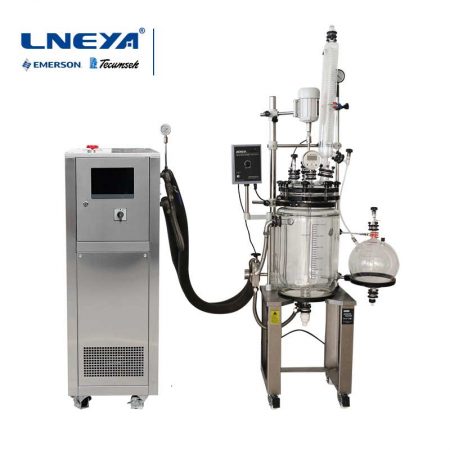
The temperature control process of the batch reactor is mainly divided into the following stages:
1. Early stage of reaction: raise or lower the temperature to the required reaction temperature.
2. Reaction process: Generally, it is a constant temperature reaction, which keeps the reaction temperature constant at a certain set value. For a multifunctional intermittent reactor, the reactions carried out are different each time, so the heat needs to be removed or supplied. Uncertainty. In order to meet the reaction needs, the temperature control requirements of this process need to be fully considered. If the temperature control is unstable, it will easily lead to a decrease in the yield and quality of the product. What’s more, it may lead to local over-temperature reactions and cause safety accidents. Therefore, whether the temperature control is stable at this stage is crucial to the safety of the reaction and the quality of the product.
3. End of reaction: Generally, it is also necessary to cool down or raise the temperature to a specified temperature. In the production process, there are strict time regulations for the intermittent reactor from the beginning of heating to the final cooling. It is generally required to conduct the reaction system according to a certain rising/lowering rate. Temperature raising/lowering operation has high requirements on the calculation of heat transfer in intermittent reactors and the selection of temperature control methods.
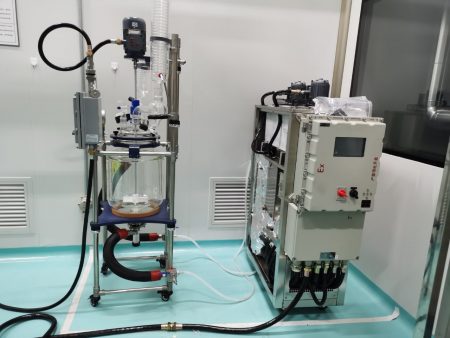
Future Prospects for Reactor Temperature Control Systems
1. Although a single TCU system has high temperature control accuracy for slow exothermic reactions, it is large in size and high in cost. Hybrid control systems have the characteristics of high flexibility, high temperature control accuracy, low cost, and good integration, and are gradually becoming mainstream.
2. Develop an intelligent temperature control system: The existing temperature control system only requires the operator to input the temperature control requirements and then the control system controls the temperature according to the input requirements. For some slow reactions, this mode can still cope with it, but for some Fast response cannot achieve good results. The reason is that the control process only controls it simply in the dimension of the control principle. At most, some complex control strategies such as cascade control, split-range control, etc. are added. There is no integration of control, process, and equipment. Come together organically.
3. Future intelligent temperature control systems should also include the following modules
① Equipment expert system: includes heat and mass transfer characteristics of different stirrings, heat transfer characteristics of reactor walls, reactor characteristics database, etc.;
② Process reaction exotherm expert system: includes exothermic curve databases for different reaction types, reaction exothermic curve databases for different products, heat transfer databases for different solvents, etc.;
③ Automatic control strategy selection expert system: includes selection guides for various control strategies for intermittent reactions, system identification systems, etc.
The above three systems + hardware together form an intelligent temperature control system. The operator only needs to select the reaction type, reaction medium, etc., and the system will select the appropriate control strategy based on the input reaction conditions and the current equipment conditions, and perform system identification in real time. Adjust the control strategy to achieve self-identification and self-adaptation of the temperature control system to achieve precise temperature control.
Forniamo progettazione e produzione di sistemi di controllo della temperatura completi. Da modelli standard a prodotti completi e personalizzati fino a 900 tonnellate. Siamo specializzati nell'assistenza ai clienti e ci dedichiamo ad aiutare ogni cliente ad avere il sistema di controllo della temperatura ottimale per le sue esigenze specifiche.
Forniamo soluzioni personalizzate non standard. Sono disponibili sia chiller a raffreddamento singolo che unità combinate di raffreddamento e riscaldamento.
E-mail: lilia@lneya.com ID WeChat: +8615251628237 WhatsApp: +86 17851209193


Sistemi di raffreddamento e riscaldamento (serie SUNDI)
- Intervallo di temperatura: -120℃ ~ +350℃
- Controllo della temperatura intelligente e di alta precisione
- Capacità di raffreddamento: 0,5kW ~ 1200kW
- Sistema completamente chiuso per prolungare la durata del fluido termico
- Ogni dispositivo è sottoposto a un test di carico di oltre 12 ore.
| Intervallo di temperatura | Serie -10 ~ +150°C | Serie -25 ~ +200°C | Serie -25 ~ +300°C | Serie -45 ~ +250°C | Serie -45 ~ +300°C | Serie -60 ~ +250°C | Serie -60 ~ +300°C | Serie -70 ~ +250°C | Serie -80 ~ +250°C | Serie -90 ~ +250°C | Serie -100 ~ +100°C | ||
| Capacità di raffreddamento | 1,5 ~ 15kW | 1 ~ 200kW | 1 ~ 200kW | 0,45 ~ 200kW | 0,9 ~ 25kW | 0,25 ~ 60kW | 0,75 ~ 25kW | 0,4 ~ 15kW | 0,3 ~ 80kW | 0,2 ~ 80kW | 0,45 ~ 80kW | ||
| Nota: qualsiasi intervallo di temperatura da -150℃ a +350℃ e qualsiasi capacità di raffreddamento possono essere personalizzati. | |||||||||||||
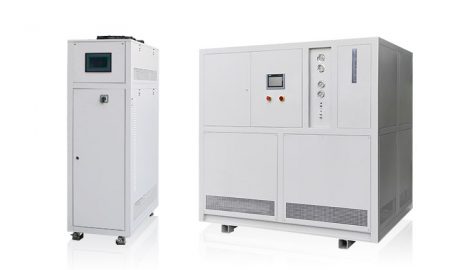
Sistemi di raffreddamento e riscaldamento (serie WTD)
- (Micro reattori a canale/tubo specializzati)
- Intervallo di temperatura: -70℃ ~ +300℃
- Pompa di circolazione ad alte prestazioni, effetto di controllo della temperatura più stabile
- Ampio intervallo di temperatura per soddisfare le esigenze di più settori industriali
- Ogni dispositivo è sottoposto a un test di carico di oltre 12 ore.
| Intervallo di temperatura | -70°C ~ +300°C | -45°C ~ +250°C | -70°C ~ +200°C | ||||||
| Capacità di raffreddamento | 1,1 ~ 7,5kW | 1,5 ~ 5,5kW | 11 ~ 50kW | ||||||
| Nota: qualsiasi intervallo di temperatura da -150℃ a +350℃ e qualsiasi capacità di raffreddamento possono essere personalizzati. | |||||||||

Circolatori di raffreddamento e riscaldamento
- Intervallo di temperatura: -45℃ ~ +250℃
- Compressore Emerson Copeland, qualità affidabile
- Funzione di autodiagnosi, dispositivi di protezione multipli di sicurezza
- Sistema completamente chiuso per prolungare la durata del fluido termico
- Ogni dispositivo è sottoposto a un test di carico di oltre 12 ore.
| Intervallo di temperatura | Serie -25°C ~ +200°C | Serie -45°C ~ +250°C | |||||||
| Capacità di raffreddamento | 1 ~ 15kW | 0,25 ~ 15kW | |||||||
| Nota: qualsiasi intervallo di temperatura da -150℃ a +350℃ e qualsiasi capacità di raffreddamento possono essere personalizzati. | |||||||||
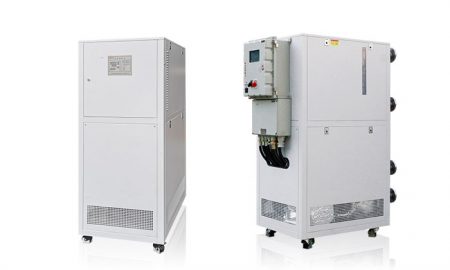
Circolatori di riscaldamento
- Intervallo di temperatura: +50℃ ~ +300℃
- Ampia area di scambio termico e velocità di riscaldamento
- Funzione di autodiagnosi, dispositivi di protezione multipli di sicurezza
- Sistema di circolazione chiuso, nessuna nebbia d'olio alle alte temperature
- Ogni dispositivo è sottoposto a un test di carico di oltre 12 ore.
| Intervallo di temperatura | +50°C ~ +170°C (serie UC) | +50°C ~ +300°C (serie UC) | +50°C ~ +300°C (serie UST) | ||||||
| Capacità di riscaldamento | 5,5 ~ 15kW | 3,5 ~ 130kW | 3,5 ~ 95kW | ||||||
| Nota: qualsiasi intervallo di temperatura da -150℃ a +350℃ e qualsiasi capacità di raffreddamento possono essere personalizzati. | |||||||||
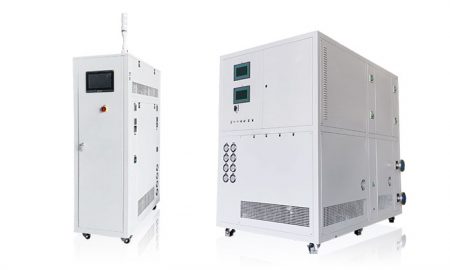
Serie TES (Controllo della temperatura per test su carburante e olio)
- Intervallo di temperatura: -85℃ ~ +250℃
- Controllore PLC Siemens e altri accessori di marca
- Funzione di autodiagnosi, dispositivi di protezione multipli di sicurezza
- Sistema di circolazione completamente chiuso, nessuna nebbia d'olio ad alte temperature
- Ogni dispositivo è sottoposto a un test di carico di oltre 12 ore.
| Intervallo di temperatura | Serie -45°C ~ +250°C | Serie -85°C ~ +200°C | Serie -60°C ~ +200°C | ||||||
| Capacità di raffreddamento | 0,3 ~ 25kW | 0,25 ~ 25kW | 3 ~ 60kW | ||||||
| Nota: qualsiasi intervallo di temperatura da -150℃ a +350℃ e qualsiasi capacità di raffreddamento possono essere personalizzati. | |||||||||
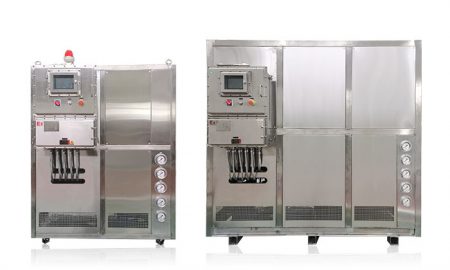
TCU Sistema di controllo della temperatura dei multireattori
- Intervallo di temperatura: -120℃ ~ +250℃
- Controllo della temperatura sigillato e ripetibile
- Sistema ausiliario di riscaldamento elettrico a olio termico incorporato
- Aggiungere moduli di scambio termico a freddo e a sorgente di calore in base alle esigenze
- Ogni dispositivo è sottoposto a un test di carico di oltre 12 ore.
| Intervallo di temperatura | Serie -45°C ~ +250°C | Serie -120°C ~ +250°C | Sistema di controllo della temperatura personalizzato | RT+10°C ~ +135°C | |||||
| Capacità di riscaldamento | 25 ~ 80kW | 25 ~ 80kW | Personalizzato | 25 ~ 300kW | |||||
| Nota: qualsiasi intervallo di temperatura da -150℃ a +350℃ e qualsiasi capacità di raffreddamento possono essere personalizzati. | |||||||||
 LNEYA
LNEYA
 简体中文
简体中文


















































































